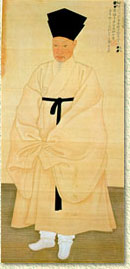|
In ancient times, Korean people mosfly wore white clothes. Only the royal family and aristocrats wore
five-colored 'hanbok' made of Chinese silk. The remainng commoners wore white.
At the end of the l3th century for about lOO years. due to Mongolia's political gressure apparel of the royal family and aristocrats began copying Mongolian clothing. 'Hanbok' fully developed when cotton seeds were secretly brought over from China in the l4th century. Since then most of the clothing wear made of cotton. Today, Koreans wear westernized suits but 'reformed hanbok' still shows us the beauty of Korean clothing. Of course, shoes were also a necessity. People of today wear dress shoes, sneakers, sandals and others. Traditional shoes were made of straw, hempcord, leather and brass. Wooden clogs for rainy days and canvas shoes were also worn.
|

|
MEN'S CLOTHING Men's clothing basically consisted of an upper coat called 'jukori' and pants. The 'Jukori' was first worn during the period of the Three Kingdoms. Pants were worn since lOOo-5000 B.C.. Pants were usually loose fitting so they were worn tied with straps around the ankles. Straps were sometimes replaced with fabric tied around the shins. Then the fabric was tied with straps around the knees. This way seemed to be much more comfortable. Choson Dynasty made 'hanbok' from the period of the Three Kingdoms much more elegant in designs. Soon kings, queens, government officials, scholars, commoners, monks had their specifically arranged 'hanbokt'. There were also clothing for ceremonial occasion and for lower classes. During Koryo Dynasty under Mongolian irnfluence, the length of the 'jukori' became shorter and strings were attached to the coat. This period formally established the 'hanbok' of the modern ages. When Youngjo and Jungjo ruled Choson, artistical culture started to develop therefore inducing luxurious and extravagant spendings. This made the 'hanbok' of this period more exquisite as ever. Hats made of bamboo horse hair, full outer dress attire, tight-fitting 'jukori', full skirts and lavish hair styles were a sign of wealth. |
|
WOMEN'S CLOTHING
Women's clothing basically consisted of an upper coat called 'jukori' and skits.
The design of the 'jukori' remained mostly the same until Koryo Dynasty when the collar,
edge of the coat, and the shape of the sleeves changed. During Choson dynasty more colors
were added to the 'jukori' and became so short they hardly covered the breasts.
The skirts did not go through many changes as the 'jukori' did but changes in the length
and width were made.
Skirts were also a way of showing one's wealth and status. Wives of government officials
wore skirts that were long and wide with gold designs added on the bottom.
Commoners wore skirts with no designs.
|

|
 |
 |
 |
 |
 |
